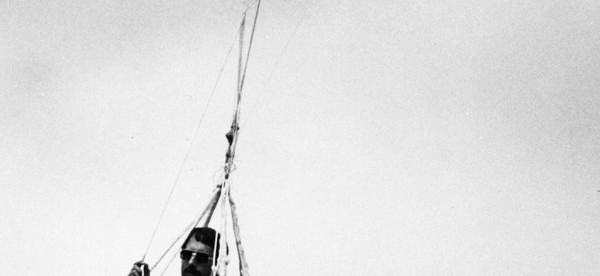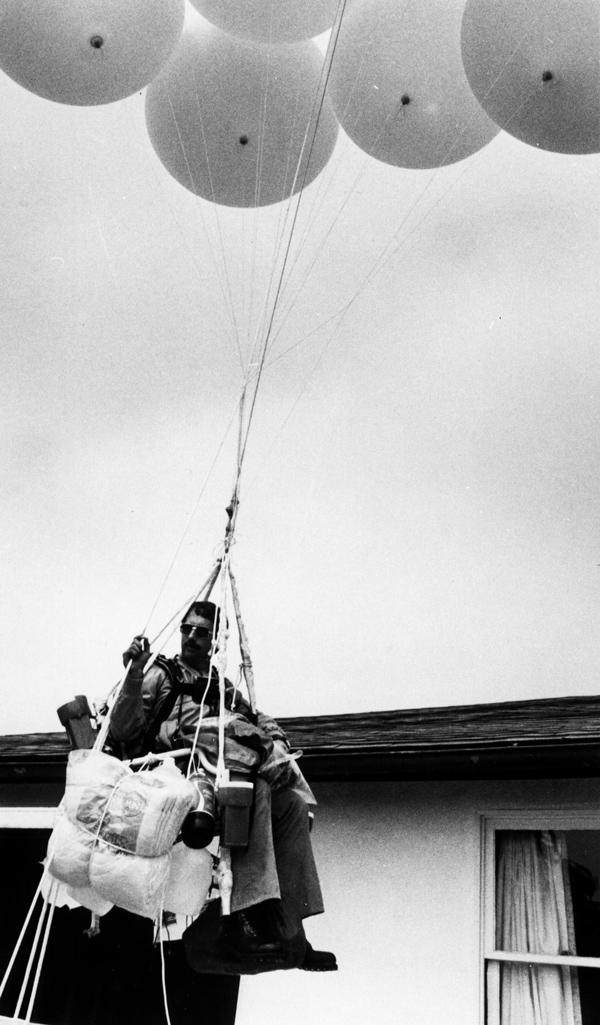Lawnchair Larry

The 2009 Disney/Pixar movie Up is an animated film and, therefore, able to take liberties with the truth pretty easily. That’s good because the premise of the movie centers on the travels of a Carl Frediricksen, a 78-year-old widower who ties tens of thousands of helium balloons to his house and, as the title suggest, goes up into the sky. The flight of Mr. Frediricksen is as fictional as it gets.
But had he tied the balloons to a lawn chair? Well, maybe Up could have been based on a true story.
In the early 1980s, Larry Walters was a truck driver from the Los Angeles neighborhood of San Pedro. He wanted to be a pilot growing up and tried to join the Air Force, but his eyesight wasn’t good enough. Nevertheless, he never quite shook his dream of flying, and as a teenager, imagined floating above the ground in a contraption lifted by weather balloons. As an adult, Walters decided to give that idea a go. He invested roughly $4,000 — his life savings — into “45 weather balloons [filled] with helium” which were tethered “to an aluminum lawn chair he purchased at Sears for $110,” per Snopes. The makeshift airship, which he called the Inspiration I, also had “a large bottle of soda, milk jugs full of water for ballast, a pellet gun, a portable CB radio, an altimeter, and a camera, also per Snopes.
It looked like this:

And it worked. On July 2, 1982, with the untying of anchors, Walters — then age 33 — went off into the wild blue yonder.
But things didn’t quite turn out as planned. Wired explained:
[Walters] intended to fly only to [an altitude of] 30 feet or so before leveling off, while munching sandwiches and pounding a few Miller Lites. Instead, he shot skyward at the rate of about a thousand feet a minute and didn’t level off until he’d reached 16,000 feet.
And to make matters worse, he was off-course. The Inspiration I floated toward Los Angeles International Airport (LAX) where it was spotted by the pilots of a Delta flight and a TWA plane. Both crews radioed back to LAX to report a man in a chair getting way too close to their jet planes.
Walters managed to land relatively safely. When the thin air and cold temperatures became too much to bear, he used the pellet gun to shoot the balloons one by one, dropping back to Earth. He crashed into some power lines, causing a 20-minute blackout in Long Beach, per the Los Angeles Times. But he suffered only minor injuries, if that. (He did, however, lose his glasses during the trip.)
And then he was arrested. At first, it wasn’t quite clear how the authorities would handle his case; as one Federal Aviation Administration (FAA) official told the New York Times, “We know he broke some part of the Federal Aviation Act, and as soon as we decide which part it is, some type of charge will be filed. If he had a pilot’s license, we’d suspend that. But he doesn’t.” But as Wired further reported, the government found some something:
He was eventually charged with operating an aircraft near an airport “without establishing and maintaining two-way communications with the control tower.” The original $4,000 fine was reduced to $1,500 when the agency dropped the seemingly more relevant charge of operating a “civil aircraft for which there is not currently in effect an Airworthiness Certificate.”
“Lawnchair Larry,” as he’d subsequently be known, never made a second flight. He took his own life in 1993 at age 44.
 Bonus Fact: Disney and Pixar deny it, but the house from Up may be based on a home in Seattle. The house, like the one in the movie, was a rare holdout when developers came to the area, and over time, the home was surrounded by huge commercial properties. A few years before Up hit theaters, the home’s then-owner, an octogenarian named Edith Macefield, decided to hold onto her home instead of cashing out (likely for nearly $1 million). Her house and her tiny lawn stayed intact until after he death in 2008, and was put up for sale in 2009, per the Washington Post. (That link has some photos of the house and the surrounding areas; it’s worth the click to see the juxtaposition.)
Bonus Fact: Disney and Pixar deny it, but the house from Up may be based on a home in Seattle. The house, like the one in the movie, was a rare holdout when developers came to the area, and over time, the home was surrounded by huge commercial properties. A few years before Up hit theaters, the home’s then-owner, an octogenarian named Edith Macefield, decided to hold onto her home instead of cashing out (likely for nearly $1 million). Her house and her tiny lawn stayed intact until after he death in 2008, and was put up for sale in 2009, per the Washington Post. (That link has some photos of the house and the surrounding areas; it’s worth the click to see the juxtaposition.)
Double bonus!: According to Slate, the tens of thousand balloons that Carl Frediricksen uses to get his house skyward in Up probably wouldn’t have been enough. Depending on the size of the balloons and the weight of Frediricksen’s house, the mission would have required at least 100,000 balloons and perhaps as many as 2.5 million.
From the Archives: Balloonacy: What happens when you release 1.5 million helium balloons over Cleveland. Nothing good.
Take the Quiz!: At least ten U.S. state capitals do not have commercial air service. Select those capitals.
Related: Don’t try this at home, but: weather balloons, a helium tank, and an aluminum lawn chair.
